Rhu (block of video heads or the rotating head unit) can be considered the main hub of any VCR or camcorder. Author of published article talks about his design, classifies the possible options, describes the process of disassembly/Assembly. All this, we hope, will help with repairmen most skillful approach to the repair of such equipment.
Attempt recording a television signal on a magnetic tape was made in forties of the last century. For these purposes initially wanted to apply conventional tape recorders with stationary magnetic heads, but with increased drawing speeds of greater width magnetic tape. Many attempts were successful-mi, but the capacity of the apparatus with a longitudinal recording method completely precluded their widespread use because of the small time record. For example, in 1953 G. firm RCA (USA) demonstrated the installation with the speed of the tape 9 m/s recording time on a roll with a diameter of 43 cm and a width of the tape 12.7 mm was equal to only about four minutes .
All subsequent achievements in the recording, television and other broadband signals associated with the use of a high speed rotating magnetic heads. For the first time this method was implemented in 1956 in the VCR firms UMRAH (USA) cross-line method of recording. The rate of feed of the tape in it was reduced to 39.7 cm/s [1 ].
Not far behind, and domestic developments. In 1959 in Leningrad was the first VCR was developed at the "Lencina". Need note that at the time the video recording in the US was attributed to strategic products and could not be sold in the countries of the CMEA, so our first the recorder was made entirely on the domestic elements and on the basis of their developments.
Further advances in video required the use of oblique-line the method of recording video signals on a tape moving at a relatively small speed. Initially it was used in reel-to-reel and then in a cassette devices. Despite the numerous options, the main node ("heart") of any VCR was, and remains, the rotating head unit (Rhu). It is used to record not only television, but audio signals and various information in analog and digital form.
In the early 70-ies for professional audio recording method was applied pulse code modulation (PCM). He was almost tested in the system, consisting of cassette VCR format U-MATIC and Converter PCM-1630 SONY Any revision serial recorder not it took as two-channel audio signals are converted the prefix PCM-1630 signals in PCM, and then in pseudoreligion signal. With the advent of cassette recorders this method of sound recording found application and for domestic purposes. Consoles PCM were widespread on the domestic market of Japan in the early 80-ies. Record sound this way used and currently in instrument format HI-8 (mostly in the video cameras).
Rotating heads for recording only the audio signals applied to digital the tape format R-DAT (DIGITAL AUDIO PACKAGE), the sale of which began in 1987 G. the Format was seen as a household, however, wide spread these recorders in the home has not received because of the high prices. Nevertheless, and in now tape recorders R-DAT continue to release many firms. Calculated they are now mainly used in professional purposes and for Amateurs high quality audio (firm FOSTEX, HHB, SONY, and TASCAM etc.).
Naturally, Rhu applied in domestic cassette recorders, and in videomagician sections camcorders (video cameras) formats VHS, VHS-C, VIDEO-8, S-VHS, S-VHS-C, MINI-DV. It should be noted that signalhorn-we formats VHS, VHS-C, S-VHS and S-VHS-C is the same, i.e. "compact" versions don't are in the full sense of the individual formats. However, Rhu equipment VHS-C/S-VHS-C radically different from their full-size prototypes, so here will consider them as different formats.
Rhu is the "heart" of the VCR to the extent that their characteristics directly affects the quality of the recorded and reproduced video, and often audible signals. Failures and malfunctions of various units and parts Rhu - phenomenon frequent. Therefore, a detailed understanding of specific design and functioning is required for efficient repair and adjustment consumer VCRs and camcorders.
Design features, geometrical dimensions and characteristics of the Rhu in the first turn are determined by the recording format. If you count from the time the first VCRs and today, it can be called many different formats a rotating magnetic recording heads. Some of them received extremely widespread, while others remained only on paper. One of the definitions of idea is this: the record format is an ordered the location on the surface of the tape lines and tracks, magnetized under the action of various signals enable the implementation of the principle of interchangeability and clearly indicating the method of performing recording and playback information [2]. The most important formats are typically registered in the IEC - international electrotechnical Commission (IEC).
In 90-e years have seen the emergence of digital formats. Fighting for their wide implementation lead the famous company SONY (DIGITAL to BETACAM, BETACAM-SX, DVCAM), MATSUSHITA (PANASONIC-D3, D5, DV, DVCPRO), JVC DIGITAL-S). Are you referring to professional formats. As for domestic, the situation is defined, most manufacturers produce equipment of format MINI-DV (mainly the camera).
Unfortunately, we have a domestic digital video cameras, and VCRs not yet received significant propagation because of its high price (us $ 1000). and more). In addition, to make full use of their capabilities need good computer with a capture card. MINI-DV cassettes three times more expensive than tapes, HI-8, that of course, further complicates the dissemination of such equipment. Given this is, consider only Rhu, widely used in household the video formats VHS/VHS-C/S-VHS/S-VHS-C, VIDEO-8, HI-8.
The requirements specified by format, can be achieved in various ways, so the design Rhu are very diverse. Since after the repair, in particular when replacing the video heads require a clear an idea about the design of specific Rhu, the order of disassembly/Assembly and the technical features of the service, it is advisable to classify of designs from various manufacturers.
Regardless of the firm, Rhu contain the following nodes: the upper cylinder (CC), installed magnetic heads; rotary transformer (W); bottom cylinder (RC), placed obliquely on the frame LSM; contactless engine DC (BL motors) electric Rhu. In some models VCR TOSHIBA in Rhu is included and pre-amplifier with powered by his generator (TOSHIBA - V856G, etc.). Firm included in JVC Urh number of VCRs nodes that provide the desired tilt it relative to the chassis at different feed rate of the tape to obtain Bespalova view (JVC - HR-DD949EE, etc.).
Although one aspect of the conditions is considered to be the diameter of the BVG (VHS publication 774 Mack in 1983) to obtain signalosome that corresponds to or a different format, with different diameters. In particular, in the apparatus VHS use BVG diameter 62 (the main part of the apparatus) and 41,33 mm (in full size cameras). Small Rhu is widely used in most models of camcorders VHS-C/S-VHS-C. LSM such cameras may not be used to work with a regular VHS tape. At the same time, applying special adapter, CD cassette can be installed in any VCR VHS. Therefore, the compatibility of formats incomplete. Yet so often the format VHS-C is attributed to the self.
In most eight-millimeter equipment used Rhu with a diameter of 40 mm. video cameras and also used Rhu diameter of 26.7 mm (SONY - CCD-TR505E, etc.). The diameter of the drum depends on the angle of circumference tape: VHS/S-VHS - 180°, VHS-C 270°, VIDEO-8/HI-8 - 220° (with a diameter of 26.7 mm - almost 360°).
From the variety of designs Rhu can be selected (according to the author) seven conditional variants (types) with different technical solutions, six of which are outlined in the table. The seventh type related special design Rhu with rotating preamps, with the so-called movable video heads, vari-angle, etc.
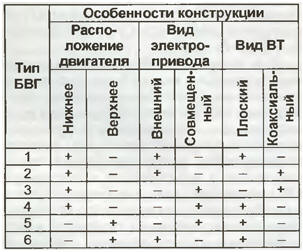
In Fig. 1 shows urh first three types, of which type 1 use in the format VIDEO-8 with diameter urh 40 mm, whereas the type 2 and 3 formats: VHS/S-VHS in diameter Urh 41,33 and 62 mm, respectively.
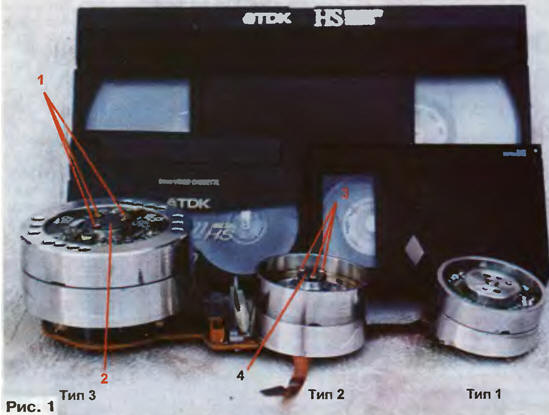
In Fig. 2 NC presents these types Rhu bottom, of which type 1 is applied in the camcorder SAMSUNG VP-U12/U15, etc., type 2 - cameras PANASONIC - NV-V9000/MS4/AG455/AG-DP200, and type 3 in VCRs PANASONIC - NV-ND70/90/95/100/F55/65/FS88/200/ AG5260/5700 and etc. of the firm MATSUSHITA.
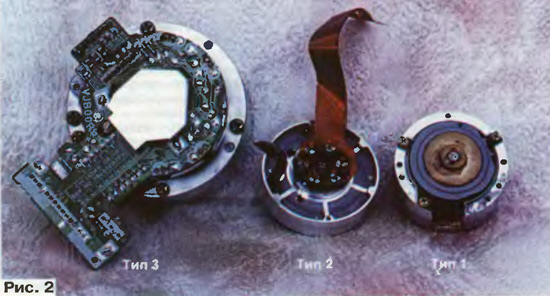
Specific names Rhu classifies each firm differently. Marking on they do not usually cause because it is a buildable site. Even marking a CC not always, and especially NC and MO. However, having information about applicability of nodes urh, in many cases, we can find analogues for hard repairable vehicles (the so-called exemption). To search for such information literature do not make sense, because manufacturers are reluctant to provide such information to the public. So pretty good repairmen and practicing Amateurs to record marking nodes repaired equipment in its own archive.
For example, consider the applicability of some NTS company MATSUSHITA (applicability of the CC requires separate consideration). Marking usually NC painted on its side. NC VEG1343A applied in the line double head of videoplayer and VCRs PANASONIC 1997-1999 release: NV-SP10/SR30/50/55/60/PO5. NC VEG0758 used in three-head the PANASONIC VCRs of the late 80's-early 90-ies of issue: NV-L20/J30 and . NC VEG1023 installed in a four video series PANASONIC SUPER DRIVE: NV-SD20/25, etc. In stereo videoplayer PANASONIC - NV-SR70/80/90/HP10 four head NC applied VEG1220. In stereo VCR PANASONIC NV-F55/F65 with six heads used NC VEG0766. Under certain conditions it is interchangeable with NC VEG1221, established in models of VCRs PANASONIC SUPER DRIVE: NV-ND70/90/95/100/AG5260, etc.
CC and especially themselves Rhu are very expensive and often scarce so that some cases when they break VCRs, and especially video cameras, become completely non-repairable or the cost of repair for unreal owners. Therefore, when performing any disassembly/Assembly of the Rhu should be particularly careful.
In many models of PANASONIC VCRs with Rhu type 3 often arise problems associated with the drying of lubrication, contamination and wear of bearings slide. Thus there is a mechanical roar, the image is like swinging horizontally, turn off the stereo channels, etc. typically, these the defects can be eliminated, which requires the disassembly/Assembly of the Rhu. Before the beginning it is necessary to fix the VC gasket by inserting it into the gap between the CC and NC. For this purpose, suitable, for example, a safety razor blade in packaging.
Begin dismantling by unscrewing the three fixing screws 1 as shown in Fig. 1, moreover, the collector of the common wire must be pre-cleared. To these slots screws in General need a special screwdriver, but you can use end hex key with a diameter of 1.6 or 1.5 mm. Sets of such keys are on sale at radio (e.g., a set of VIDEO SERVICE TOOL VHS/BETA 8034-549-11, etc.).
Then remove the cover 2, which serves both the upper journal bearing slide. It should be borne in mind that the magnet 1 of the rotor of the motor shown in Fig. 3 in the disconnected state, tightly drawn to the stator 4, so rotate EC no means impossible (previously inserted gasket protects the video heads from damage).
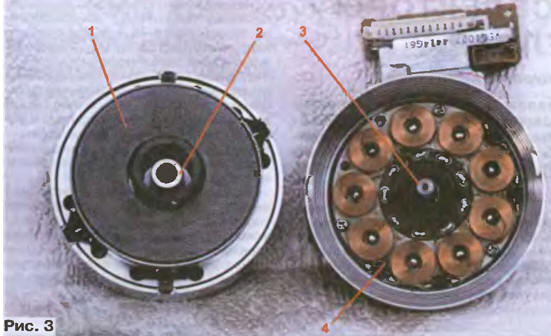
The next operation is the removal of the split locking washer under the lid 2 (see Fig. 1). To remove it in the General case we need a special device, but you can use miniature pliers or tweezers. Their width the tip must be less than 1.6 mm. Often practised by picking pucks screwdrivers are not recommended, as it usually leads to damage of the rotor hub the engine is made of aluminum alloy, after which normal operation devices, especially the stereo and mounting, it is possible to achieve very rarely due to the misalignment of the CC and NC and the appearance of eccentricity.
Further step - the removal of the CC with the rotors of the engine and WATTS. This should be done very carefully, without disturbing the alignment so as not to damage the fragile ferrite magnetic circuits W and its windings. Then clean from dirt steel bearing shaft 3 (Fig. 3) and the inner surface of the sleeve bearings 2 alcohol-gasoline mixture or ethanol, or gasoline) and lubricate the bearings a little oil for sewing machines (preferably purified varieties or hour).
Then set CC to the original position, not forgetting to insert the locking gasket. To return to the place a split washer is not necessary, as the magnet rotor with sufficient force is attracted to the base. And finally, close the shaft cover 2 (see Fig. 1), pre-clearing and brushing it the inner surface of special ntagasawa-ing grease (militana, purified vaseline, etc.), lubricant (for car use). Mounting screws 1 screw and tighten gradually and alternately, so as not to avoid straining lid.
In most cases, the previous operations, are sufficient to restore normal quiet operation Rhu. In rare cases be required polishing the inner surface of the bearing 2 (Fig. 3) the wiring from cotton fabric, grated polishing paste.
Similar construction is used Rhu type 2. In the exploded view shown in Fig. 4. Dismantle it after unscrewing the 3 screws and removing the cover 4 (see Fig 1). Differences from Rhu type 1 is the lack of a split locking washer and the connection terminals of the video heads CC 4 (Fig. 4) with the windings of the rotor 1 through W spring-loaded gold plated contacts (Rhu type 1 - solder joints). In Fig. 4 also shows the rotor of the motor 2, the supporting shaft 3 and the bearing 5.
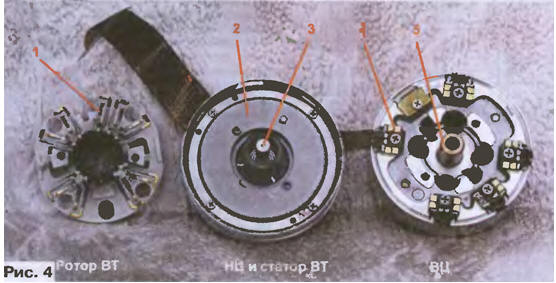
Design features and methods of disassembly/Assembly Rhu type 5 considered in [3], and other types - in albums "LPM VCRs and camcorders, repair, adjustment", sold at radio.
The greatest number of failures urh, including due to natural wear, have on CC. Their designs and types there are many dozens. Information on them the use and interchangeability is of great practical interest as for repairmen and hobbyists. This will be covered in other publications.
Literature
Author: J. Peter and Paul, Taganrog






